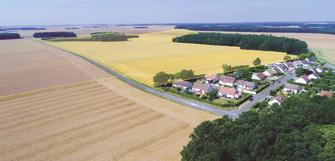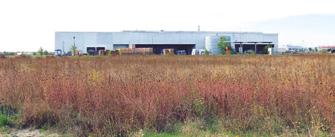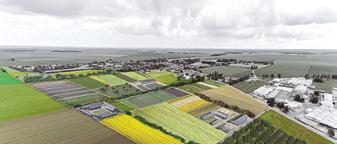
5 minute read
Pays de Dreux (FR
PROJECT SCALE — XL/S – territory / architecture + LOCATION — Pays de Dreux Agglomeration POPULATION — 115,00 inhab.
STRATEGIC SITE — 1047 km 2
Advertisement
PROJECT SITE — St-Lubin-des-Joncherets 40 ha, Brezolles 10-15 ha, Tremblay-les-Villages 10-15 ha context
SAINT-LUBIN-DES-JONCHERETS

SAINT-LUBIN-DES-JONCHERETS
BREZOLLES


TREMBLAY-LES-VILLAGES SITE PROPOSED BY — Pays de Dreux Agglomeration OWNER OF THE SITE — Private and public land POST-COMPETITION PHASE — Urban study, master plan, urban project management with a developer common to the three sites
Pays de Dreux Agglomeration —
1. WHAT ARE THE GOALS OF THE SITE MUTATION? The Agglomeration seeks to test a new model of activity zone adapted to the challenges of the future (land sanctification, ecological transition, economic changes). This experiment will help develop a certain exemplarity in the design, development and management of a productive space that is better integrated into its environment —the rural/peri-urban landscape— and into the daily life of inhabitants and workers.
2. HOW CAN THE SITE BE INTEGRATED IN THE ISSUES OF PRODUCTIVE CITIES? HOW DO YOU CONSIDER THE PRODUCTIVITY IS-SUE?
The purpose of the sites is to accommodate companies (industrial, craft, etc.) in spaces that are truly integrated into their environment. They are also located in a productive territory through its agricultural sector. This cereal production, widely exported outside the territory, also comes with smaller forms of agriculture and local food production. A transition to more diversified agriculture is an integral part of the transformation of the sites and the territory.
3. HAVE YOU ALREADY DEFINED A SPECIFIC PROCESS FOR THE URBAN AND/OR ARCHITECTURAL DEVELOPMENT OF THE SITE AFTER EUROPAN COMPETITION?
The Agglomeration has not defined a specific process for the followup yet. Some options are available to the community: — A transversal AMO to build specifications for our future productive spaces, on the Europan sites as well as on a more general scale of the territory; — A new competition between the three teams on the basis of reworked specifications. In any case, the community wants to rely on all the projects submitted to build the new program and take full advantage of this ambitious approach.

SAINT-LUBIN-DES-JONCHERETS

BREZOLLES

Urbanisme agricole
AUTHOR(S) — Lucas Fontaine (FR), Jules Gauffeny (FR), Samuel Hervault (FR), Architects TEAM POINT OF VIEW — We grew up in the country. It was easy to organize games and explorations around our homes, cycling races around hamlets, tadpole fishing in ditches or giant hide-andseek in cornfields. These experiences were our first links with rural landscape. The goal of our work was not to recreate a nostalgic the country. But these memories did not leave us during the project’s development. For the competition, the theme chosen concerns the development of villages. We felt that it was important to question how the urbanization of the countryside was organized because the current planning does not make way for these areas of freedom. Thinking about the extension of a commune means, at first, thinking of what makes its limit or its boundary. The boundary is a common term used in country planning project. But how to define it? Does it exist? JURY POINT OF VIEW — The team proposes “constructible agricultural zones” on the edge of town centres combining small housing programmes with diversified agriculture (storage, production, breeding), thus attempting to go beyond urban zoning regulations for housing and agriculture. The project is divided into six test sites associated with a specific type of activity and dealt with architecturally. The idea of “productive countryside” proposed by the team advocates a new type of controlled, sparse urbanization allowing housing and agricultural activity to coexist.
TREMBLAY-LES-VILLAGES

PAYS DE DREUX (FR) — WINNER
CONTACT — 9 rue Boulay Paty, 35000 Rennes (FR) +33 640606013 / +33 699552394
gauffenyfontaine@gmail.com

Ecological Magnets
AUTHOR(S) — Gaetan Brunet (FR), Architect, urbanist; Chloé Valadié (FR), Architect urban development project, they have to integrate, look for connections with the environments in which they act and finally trigger territorial transformations. Our method and proposal take the form of “Ecological Magnets” — attractive poles that initiate relations with all the scales that structure the territory. Extroverted objects that feed the four ecologies of the Pays de Dreux —Economy, Ecology, Energy, Ecosystem—, both in their internal mutualised logics, as well as in the relationship with their surroundings. It is therefore necessary to think of these ZAE as a collective effort: that is to say, to build singular projects, adapted to the physical properties of the sites and the needs of the Pays de Dreux, and built with the stakeholders in order to activate the ecological transition through agile and dynamic entrepreneurial ecosystems. on the improvement and connection of local factors and resources in order to punctuate and activate the territory. They are presented as isolated mechanisms spurring on change at a larger scale. Contrary to the logic of business zones, the team proposes setting up pioneer demonstration programs linked to the environment. A project with a pertinent territorial approach based on individual attracting programmes, which constitute an alternative to the largescale business parks.


PAYS DE DREUX (FR) — RUNNER-UP
CONTACT — UR bureau d’architecture et d’urbanisme 24 rue Davoust F, 93500 Pantin (FR)
TEAM POINT OF VIEW — There can be no ZAE “model”. Like any

JURY POINT OF VIEW — The concept of “Ecological Magnets” relies office@ur-bau.eu / www.ur-bau.eu










